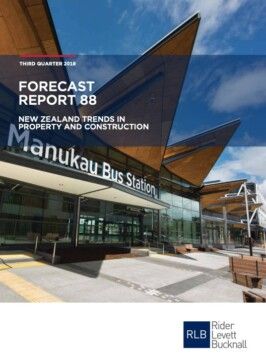The Rider Levett Bucknall (RLB) Forecast 88 report – New Zealand Trends in Property and Construction – released today confirms construction activity eased across the residential, commercial and government sectors over the first quarter of 2018.
Prepared by the New Zealand Institute of Economic Research (Inc.) (NZIER) exclusively for RLB, Forecast 88 highlights that despite this, the level of construction activity remains high. Underlying construction demand remains strong, but growth in construction is hampered by continued capacity and financing constraints in the construction sector.
Net migration slowing
Grant Watkins, Director of RLB in Wellington said, ‘Net migration continues to slow on the back of an easing in the number of people moving to New Zealand from overseas. The number of people leaving the country is also lifting, partly driven by the departure of people that came in on temporary work and student visas in the past few years, as the tenure of these visas comes to an end.’
‘We expect that as the Australian labour market continues to improve this would support further net outflows across the Tasman. Concrete usage fell across many regions, including Auckland and Canterbury. This points to an easing in construction activity in these regions,’ he added.
Construction activity strengthening in halo regions
According to the RLB report, these declines in the major regions contrast with the rise in concrete usage in the ‘halo’ regions of Waikato and Bay of Plenty, indicating strengthening construction activity in these regions.
However, capacity and financing constraints in the construction sector will limit the extent to which activity can ramp up. Although demand is strong, the fragmented nature of the sector means that construction companies are grappling with low operating margins, labour shortages and difficulty accessing finance. Many smaller and midsized construction companies also face the challenge of cash-flow issues, with delays in payment and completion of projects having a short-term effect on their bottom line.
Social buildings top driver of growth
Grant continued, ‘Demand for social buildings is the top driver of growth in the non-residential construction demand over the past year. Added to that, improved confidence in the agriculture sector is flowing through to a recovery in on-farm investment, with growth in demand for industrial and farm buildings as a result. In contrast, demand for accommodation and office buildings have declined over the past year.’
Population growth (while moderating) and tourism demand will underpin many of the longer-term trends such as offices for the higher number of white collar workers, and new accommodation buildings in response to strong domestic and international tourism activity.
Auckland leads growth in non-residential
According to RLB’s Forecast 88, Auckland continues to lead growth in non-residential construction demand over the past year. The decline in demand for office buildings was offset by much stronger demand for social, cultural and religious buildings, as well as storage and industrial buildings.
Although consent issuance for accommodation buildings fell over the past year, RLB expects a recovery given continued capacity pressures in the Auckland tourism sector.
Growth in non-residential construction demand in Waikato was broad-based, reflecting the effects of population growth and recovery in on-farm investment as dairy income improves.
Wellington non-residential demand drops sharply
In contrast, there was a sharp drop in non-residential construction demand in Wellington, driven by reduced demand for new office space and retail outlets. Pessimism amongst Wellington businesses in the wake of the new government taking office has the potential to further weigh on investment in new commercial buildings over the coming year.
Grant concluded, ‘RLB forecasts construction cost inflation to lift to 4.6% in early 2019 before moderating to 4% by the end of 2019. The exit of Fletcher Building from the ‘vertical construction’ sector increases the uncertainty over the degree of construction cost escalation, but large cost increases are likely to see a push-back in demand, as developments no longer become financially feasible.’
Download PDF: RLB New Zealand Trends in Property and Construction Q3 2018
FURTHER INFORMATION:



